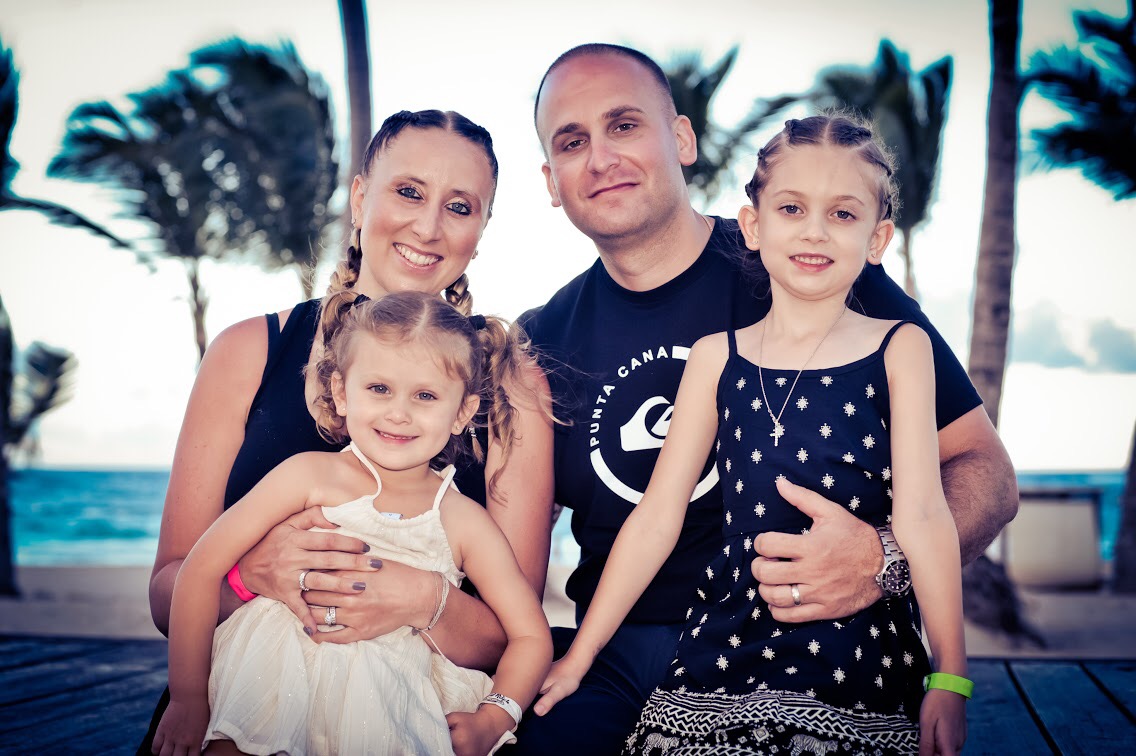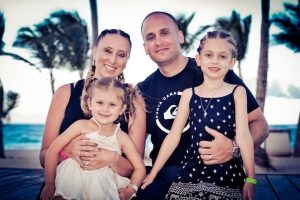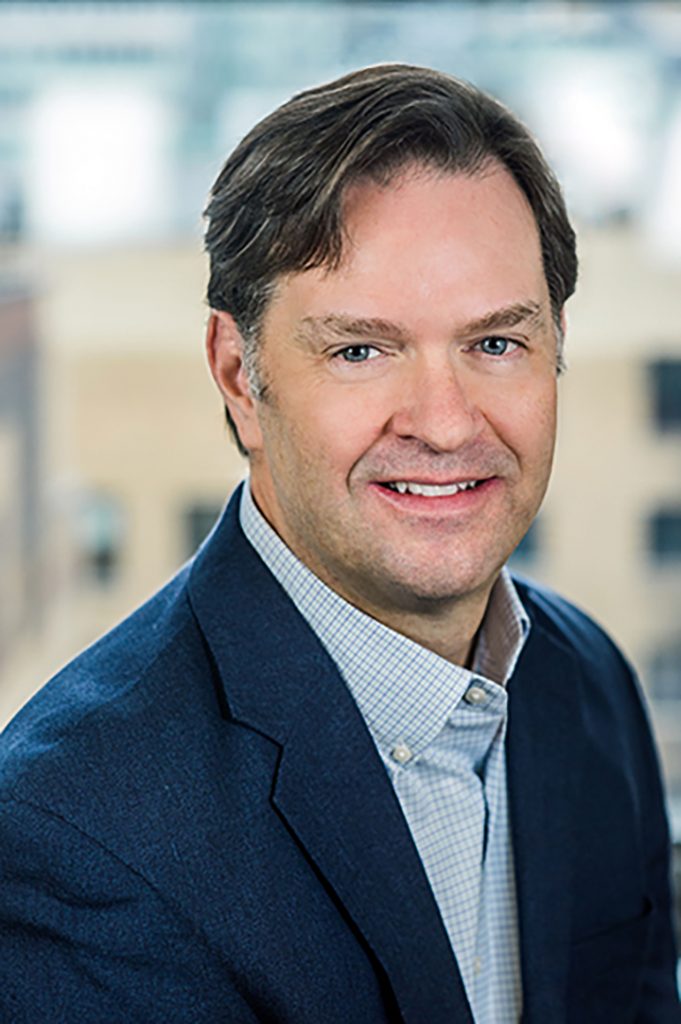Young-onset Patients, Like This 34-Year-Old Mom, Focus of Parkinson’s Foundation and Awareness Month

Christina Korines, a young-onset PD patient, and her family. (Photo courtesy of Christina Korines)
Christina Korines was 22 — a recent college graduate and a newly minted Spanish teacher — when she noticed a tremor in her right foot. That tremor soon progressed into a pronounced limp, and an arm that didn’t swing when she walked.
Something was terribly wrong, she just didn’t know what. Neither did her doctors.
”It was exhausting. It was like my leg wouldn’t listen to my body,” Korines told Parkinson’s News Today by phone from River Vale, New Jersey. “It was like something had sliced me right down the middle.”
Her heart told her it was multiple sclerosis, but that illness was ruled out. One specialist fingered essential tremor; another, generalized anxiety disorder. Still another misdiagnosed her with Huntington’s disease. Next, it was Wilson’s disease.
“My husband said ‘let’s keep looking,’” said the mother of two girls, ages 3 and 7. “So I kept fighting.”
She also kept teaching. But her handwriting had become so small, it was nearly illegible for her students. Her voice turned softer and quieter. She made excuses to avoid walking in her middle-school classroom, and even enlisted the help of an aide.
Still, not knowing what was happening was the most frustrating thing.
One doctor off-handedly broached Parkinson’s disease (PD), but dismissed the prospect because of her age, and she had no known family history of the disorder. But the seed had been planted.
One fateful day in late 2017, she went online and looked up Parkinson’s. Soon, she had an appointment with a movement specialist at NYU Langone Health. What came next was a minor miracle: after 10 years, five neurologists, four MRIs, and seemingly rivers of drawn blood, she finally had a diagnosis: young-onset Parkinson’s disease.
Young-onset PD, relatively rare
“I was totally shocked, but in the most weird way relieved,” said Korines, who immediately began treatment, and quickly noticed improvement. “I feel like that was the start of the rest of my life that day. I knew that I could take control as much as I could, and make a game plan.”
The average age for Parkinson’s onset is typically 60. Only around 4 percent of patients are diagnosed before age 50; the disease is considered young-onset in people diagnosed before the age of 40. And while the youngest known Parkinson’s patient was diagnosed at 12, Korines has yet to meet a patient under age 72. In her online social media groups, she has come to know a few 40-year-olds.
After she was diagnosed and subsequently retired, her husband — a law enforcement sergeant and her high-school sweetheart — persuaded her to sell their house and move with the family to her parents’ home. He wanted to make sure she’d be looked after while he worked.
These days, Korines, 34, is mostly doing OK. While she had no athletic proclivity prior to PD, she’s now totally into non-contact boxing to help manage symptoms.
“When you hit those mitts, the wires aren’t crossed anymore,” she said. “When I walk out, you wouldn’t even know I was sick.”
She does have symptom flair-ups each month, although her tremors are controlled. She tries to lay down during “off periods,” when her medications are wearing off and it’s not yet time for a new dose. Korines also regularly deals with dystonia — repetitive muscle cramping — in one of her feet.
She has problems with comprehension when trying to multitask, she said. But it’s anxiety that really gets her down. Along with depression, the condition is caused in some patients by chemical changes in the brain.
“I’d take any amount more of the physical pain than a second of the anxiety, because of how crippling it is,” Korines said. “It’s ridiculous, it’s absurd, but it’s there.”
Foundation takes the lead
Korines has found fellowship in the Parkinson’s Foundation, which aims to make life better for people with PD by improving care and advancing research toward a cure. Her story, along with other patient narratives, is featured on the organization’s website.
”When you’re so young with Parkinson’s you feel a little lost, but they provided me with support, and just really embraced me,” she said.
John L. Lehr has been the nonprofit’s president and CEO for just over two years. The organization is gearing up for April, Parkinson’s Awareness Month. Toolkits and PD community tips are
ready, as are opportunities for patients to share, via videos and photos, inspirational tips and messages. Highlighting the importance of disease awareness, the theme for this year is #KeyToPD.
Some 1 million Americans are thought to have Parkinson’s; Lehr expects that number to reach up to 1.2 million within 10 years. About 10 million people have PD worldwide, he said in a phone interview.
The hiring of Lehr, who has more than two decades of nonprofit fundraising and management experience, followed the merger of two legacy organizations: the National Parkinson Foundation and the Parkinson’s Disease Foundation. On his watch, the newly formed, 100-employee Parkinson’s Foundation has enhanced programming and seen revenue rise by 40 percent.
”What’s so important is the reinvestment in mission programs,” Lehr said. “You always want to do right by the community. It’s a very idiosyncratic disease — no two people have the same course — so we want to make sure it’s not one-size-fits-all.”
About 60,000 new Parkinson’s cases appear annually, he said, much of that owing to better diagnostics. To help address this, the foundation will launch a “newly diagnosed” initiative during April focusing on its 45 Centers of Excellence around the world, including 31 U.S. centers. Beyond setting standards globally, the centers provide expert care to more than 145,000 people.
“It’s going to be a full-court press, including with social media,” he said. “We want engagement early and often.”
The importance of exercise
Lehr said patients with young-onset PD, like Korines, are looking at many years of coping because of the disease’s progressive nature. Those diagnosed in their 60s can live several decades and longer, he said, if they’re proactive.
Still, major science hurdles abound.
“The last 20 to 30 years, we’ve learned a lot,” he said. “But there’s no real therapy, let alone a cure. We don’t know what causes it — genetics, the environment, or some combination. Answers to those big questions will prevent, slow, or even halt the disease.”
One of the foundation’s biggest efforts is its Genetics Initiative, dedicated to using genes to uncover mechanisms responsible for hindering or stopping the disease’s progression. Announced last year, it’s the first national Parkinson’s study to offer free genetic testing plus counseling for Parkinson’s-related genes, including the GBA and LRRK2 mutations.
Its goal is to track the genetic makeup of 15,000 PD patients across 50 U.S. sites within a year, with the first patients expected to be enrolled at six sites in April.
The pilot is an expansion of the Foundation’s ongoing 10-year-old Parkinson’s Outcomes Project. With more than 12,000 participants in five countries, it’s the largest clinical study of PD to date, and acts to help patients better manage their disease and receive better care. It also tracks and reports on research findings, and expects that those enrolled might be more interested in participating in clinical trials.
Along with its array of patient and caregiver support and fundraising efforts, the Parkinson’s Foundation has been busy on other fronts, recently hosting its first medical marijuana and Parkinson’s conference, and creating its first patient-centered research agenda for women.
The most significant Parkinson’s development during his tenure so far, Lehr said, has not been drug or even diagnostic discovery, but rather the heightened awareness of exercise.
“There will always be advancements in therapeutics,” he said. “But the importance of staying active — be it walking, boxing, dancing — and how it functions as good as a drug, has been the biggest news.”








